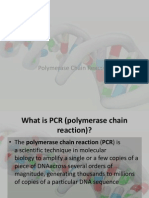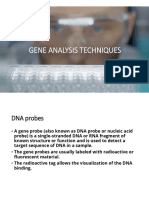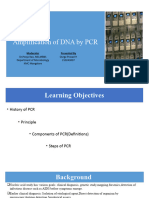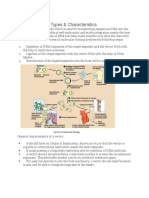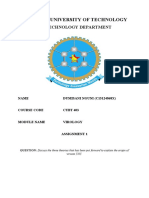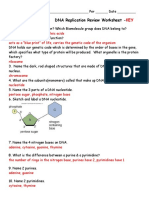0 ratings0% found this document useful (0 votes)
13 viewsFISH GENETICS Techniques
FISH GENETICS Techniques
Uploaded by
Hanna Beth Butiong TandayagThe document describes DNA extraction, polymerase chain reaction (PCR), and gel electrophoresis. DNA extraction is used to isolate DNA from cells by breaking open cells, removing debris, and purifying the DNA. PCR amplifies specific DNA regions using DNA polymerase. It works by repeated heating and cooling of the DNA. Gel electrophoresis separates DNA fragments by size and can estimate fragment length by comparing to a DNA ladder run on the same gel.
Copyright:
© All Rights Reserved
Available Formats
Download as PDF, TXT or read online from Scribd
FISH GENETICS Techniques
FISH GENETICS Techniques
Uploaded by
Hanna Beth Butiong Tandayag0 ratings0% found this document useful (0 votes)
13 views22 pagesThe document describes DNA extraction, polymerase chain reaction (PCR), and gel electrophoresis. DNA extraction is used to isolate DNA from cells by breaking open cells, removing debris, and purifying the DNA. PCR amplifies specific DNA regions using DNA polymerase. It works by repeated heating and cooling of the DNA. Gel electrophoresis separates DNA fragments by size and can estimate fragment length by comparing to a DNA ladder run on the same gel.
Original Description:
Fish Genetics Molecular Techniques
Copyright
© © All Rights Reserved
Available Formats
PDF, TXT or read online from Scribd
Share this document
Did you find this document useful?
Is this content inappropriate?
The document describes DNA extraction, polymerase chain reaction (PCR), and gel electrophoresis. DNA extraction is used to isolate DNA from cells by breaking open cells, removing debris, and purifying the DNA. PCR amplifies specific DNA regions using DNA polymerase. It works by repeated heating and cooling of the DNA. Gel electrophoresis separates DNA fragments by size and can estimate fragment length by comparing to a DNA ladder run on the same gel.
Copyright:
© All Rights Reserved
Available Formats
Download as PDF, TXT or read online from Scribd
Download as pdf or txt
0 ratings0% found this document useful (0 votes)
13 views22 pagesFISH GENETICS Techniques
FISH GENETICS Techniques
Uploaded by
Hanna Beth Butiong TandayagThe document describes DNA extraction, polymerase chain reaction (PCR), and gel electrophoresis. DNA extraction is used to isolate DNA from cells by breaking open cells, removing debris, and purifying the DNA. PCR amplifies specific DNA regions using DNA polymerase. It works by repeated heating and cooling of the DNA. Gel electrophoresis separates DNA fragments by size and can estimate fragment length by comparing to a DNA ladder run on the same gel.
Copyright:
© All Rights Reserved
Available Formats
Download as PDF, TXT or read online from Scribd
Download as pdf or txt
You are on page 1of 22
DNA EXTRACTION
POLYMERASE CHAIN REACTION
GEL ELECTROPHORESIS
HANNA BETH B. TANDAYAG
Instructor
Elec 2 (Fish Genetics & Breeding
The Central Dogma
Structure of DNA
DNA EXTRACTION
• A routine procedure used to isolate DNA from the nucleus
of cells.
• A fundamental step in many biological and medical
research applications, such as genetic analysis, forensics,
diagnosis of diseases, and development of genetically
modified organisms.
• The process of DNA extraction involves breaking open cells
or tissues to release the DNA molecules from the nucleus,
which is then purified and concentrated.
DNA EXTRACTION
To isolate DNA, we have to break down both cell and nuclear
membranes. Then we have to remove cell debris. The final
step will be to precipitate and purify DNA. DNA extraction
consists of three stages:
1. Breakdown (or so-called lysis) of cell and nuclear membrane that is
achieved by adding detergents
2. Removal of cell debris and proteins is done by adding proteases.
Proteases are enzymes that digest proteins
3. DNA purification and precipitation are done by adding ice-cold alcohol
ethanol or isopropanol.
DNA EXTRACTION
• DNA precipitate
When an ice-cold alcohol is
added to a solution of DNA, the
DNA precipitates out of the
solution and if there is enough
DNA in the solution, you may see
a stringy white mass
DNA EXTRACTION STEPS
DNA EXTRACTION
✓ The DNA sample can now be further purified (cleaned). It
is then resuspended in a slightly alkaline buffer and
ready to use
✓ It is important to know the concentration and quality of
the DNA.
✓ Optical density readings taken by a spectrophotometer can
be used to determine the concentration and purity of DNA
in a sample. Alternatively, gel electrophoresis can be
used to show the presence of DNA in your sample and give
an indication of its quality.
DNA Replication and DNA Polymerase
Polymerase Chain Reaction - PCR
• PCR amplifies DNA
– Makes lots and lots of copies of a few copies of
DNA
– Can copy different lengths of DNA, doesn’t have to
copy the whole length of a DNA molecule
• One gene
• Several genes
• Lots of genes
• Artificial process which imitates natural DNA
replication
Polymerase Chain Reaction - PCR
• Sometimes called "molecular photocopying," the
polymerase chain reaction (PCR) is a fast and
inexpensive technique used to "amplify" - copy -
small segments of DNA. Because significant
amounts of a sample of DNA are necessary for
molecular and genetic analyses, studies of isolated
pieces of DNA are nearly impossible without PCR
amplification.
PCR revolutionized the study of DNA to such an
extent that its creator, Kary B. Mullis, was
awarded the Nobel Prize for Chemistry in 1993.
Polymerase Chain Reaction - PCR
• Once amplified, the DNA produced by PCR
can be used in many different laboratory
procedures.
Ex. Most mapping techniques in the Human Genome Project
(HGP) relied on PCR.
PCR is also valuable in a number of laboratory and
clinical techniques:
1. DNA fingerprinting,
2. detection of bacteria or viruses (particularly AIDS)
3. diagnosis of genetic disorders.
How PCR Works
• Reagents Needed
– DNA sample which you want to amplify
– DNA polymerase
• Taq DNA polymerase – Works at high temperature
– Nucleotides
• Called dNTPs
– Pair of primers
• One primer binds to the 5’ end of one of the DNA strands
• The other primer binds to the 3’ end of the anti-parallel DNA
strand
• Delineate the region of DNA you want amplified
– Water
– Buffer
How PCR Works
• Protocol
– Put all reagents into a PCR tube
– Break the DNA ladder down the middle to create two
strands, a 5’ to 3’ strand and a 3’ to 5’ strand
• Melting or heat denaturation
– Bind each primer to its appropriate strand
• 5’ primer to the 5’ to 3’ strand
• 3’ primer to the 3’ to 5’ strand
– Annealing
– Copy each strand
• DNA polymerase
– Extending
How PCR Works
• Temperature Protocol
– Initial Melt: 94ºC for 2 minutes
– Melt: 94ºC for 30 seconds
– Anneal: 55ºC for 30 seconds 30-35
cycles
– Extend: 72ºC for 1 minute
– Final Extension: 72ºC for 6 minutes
– Hold: 4ºC
How PCR Works
Gel Electrophoresis of DNA
• Gel electrophoresis detects the presence of DNA
in a sample
• Gel electrophoresis detects the number of
nucleotides in a fragment of DNA
– e.g., the number of nucleotides in a DNA region which was
amplified by PCR
– Is a rough estimate, is not exact, need more sophisticated
sequencing techniques to get an exact number of
nucleotides
– Can be used to tentatively identify a gene because we
know the number of nucleotides in many genes
How Gel Electrophoresis of DNA Works
• A sample which contains fragments of DNA is forced by an
electrical current through a firm gel which is really a sieve with
small holes of a fixed size
– Phosphate group in DNA is negatively charged so it is moved
towards a positive electrode by the current
– Longer fragments have more nucleotides
• So have a larger molecular weight
• So are bigger in size
• So aren’t able to pass through the small holes in the gel and get
hung up at the beginning of the gel
– Shorter fragments are able to pass through and move farther along
the gel
– Fragments of intermediate length travel to about the middle of the
gel
• DNA fragments are then visualized in the gel with a special dye
• The number of nucleotides are then estimated by comparing it to a
known sample of DNA fragments which is run through the gel at the
same time
How Gel Electrophoresis of DNA Works
• Reagents Needed
– Sample of DNA fragments
– Known sample of DNA fragments
• DNA ladder
– Gel
• Agarose
– Dye to visualize the movement of the sample as it is
traveling through the gel
• Loading dye – Blue juice
• So know when to stop so sample doesn’t just run out of
the gel
– Dye to visualize DNA after it has traveled to its final
spot in the gel
• Syber® Safe
– Buffer
How Gel Electrophoresis of DNA Works
• Equipment Needed
– Box to hold the gel
– Comb to create small wells in the agarose gel
to put the DNA sample into at the beginning of
the gel
– Positive and negative electrodes to create the
electrical current
– Power supply
– Gel photo imaging system
How Gel Electrophoresis of DNA Works
You might also like
- Niche PartitioningDocument3 pagesNiche PartitioningKhang Lq100% (2)
- BIOL 1408 Final Exam Review - Chapter 1 - 10 - Concepts and ConnectionsDocument8 pagesBIOL 1408 Final Exam Review - Chapter 1 - 10 - Concepts and ConnectionsTristan ScottNo ratings yet
- Lec 5 DNA Extraction and PCRDocument25 pagesLec 5 DNA Extraction and PCRSaif MohamedNo ratings yet
- Genome Acquisition - Sangers's SequencingDocument30 pagesGenome Acquisition - Sangers's SequencingMohana Priya AchuthanNo ratings yet
- DNA Fingerprinting - K.RasikaDocument22 pagesDNA Fingerprinting - K.RasikahatijabanuNo ratings yet
- 1-2 PCR and Gel ElectrophoresisDocument22 pages1-2 PCR and Gel ElectrophoresisdewiulfaNo ratings yet
- Y13 PCR & DNA ProfilingDocument16 pagesY13 PCR & DNA ProfilingFaye SweeneyNo ratings yet
- PCRDNA Sequencing Forensic Pedigree (1)Document35 pagesPCRDNA Sequencing Forensic Pedigree (1)sanidhaya025No ratings yet
- DNA Extraction MethodsDocument22 pagesDNA Extraction MethodsGarshel KellyNo ratings yet
- Dna Bar CodingDocument25 pagesDna Bar CodingUmer AliNo ratings yet
- Application of Genetics IIDocument47 pagesApplication of Genetics IImakristelanneaNo ratings yet
- Sequencing TechnologiesDocument25 pagesSequencing TechnologiesOhhh OkayNo ratings yet
- 3 SequencingDocument30 pages3 Sequencingsana javaidNo ratings yet
- Polymerase Chain Reaction: "Xeroxing" DNADocument41 pagesPolymerase Chain Reaction: "Xeroxing" DNALida KadavilNo ratings yet
- PCR & Gel-03Document17 pagesPCR & Gel-03Nishan DarshakaNo ratings yet
- Molecular Diagnostic MethodsDocument36 pagesMolecular Diagnostic MethodsSorin LazarNo ratings yet
- Dna Profiling Part 1Document31 pagesDna Profiling Part 1nby_jNo ratings yet
- DNA SequencingDocument81 pagesDNA Sequencingzohasaleem14.02No ratings yet
- Polymerase Chain Reaction (PCR)Document66 pagesPolymerase Chain Reaction (PCR)Gaurav ThakurNo ratings yet
- Final Pcr Lec 2022-1Document73 pagesFinal Pcr Lec 2022-1Pulok HasanNo ratings yet
- DNA SequencingDocument21 pagesDNA SequencingAsfoor gake1100% (1)
- Isolasi DNA Dan PCRDocument21 pagesIsolasi DNA Dan PCRFrancisko AngeloNo ratings yet
- 23112020213036-DNA Sequencing PPTDocument23 pages23112020213036-DNA Sequencing PPTgundlapalli.2023No ratings yet
- 14th WeekDocument21 pages14th WeekMoonHoLeeNo ratings yet
- Note Jul 29, 2014 PDFDocument3 pagesNote Jul 29, 2014 PDFbob thabuilderNo ratings yet
- Nucleic Acid Biotechnology Techniques: Mary K. Campbell Shawn O. FarrellDocument40 pagesNucleic Acid Biotechnology Techniques: Mary K. Campbell Shawn O. Farrellleng cuetoNo ratings yet
- DNA Is The Genetic MaterialDocument17 pagesDNA Is The Genetic Materialmozhi74826207No ratings yet
- Polymerase Chain ReactionDocument55 pagesPolymerase Chain ReactionFareeha ZahoorNo ratings yet
- PCR AssignmentDocument3 pagesPCR Assignmentsurbhimakwana3No ratings yet
- Next Generation Sequencing - FinalDocument33 pagesNext Generation Sequencing - Finallynn100% (1)
- 10 - Basic Recombinant DNA TechniquesDocument77 pages10 - Basic Recombinant DNA TechniquesNguyenHongThamNo ratings yet
- Lecture #3Document115 pagesLecture #3naimaNo ratings yet
- Ch.3 Dna TechnologyDocument35 pagesCh.3 Dna Technologyวรรณศิริ คงสมนึกNo ratings yet
- Isolation and Characterization of DNADocument75 pagesIsolation and Characterization of DNANathaniel CastasusNo ratings yet
- Gene Analysis Techniques: DNA ProbesDocument27 pagesGene Analysis Techniques: DNA Probeskaira.raina.ghoshNo ratings yet
- Biomol 12 - Molecular Biology TechniquesDocument76 pagesBiomol 12 - Molecular Biology TechniquesErin ArmaidaNo ratings yet
- MBB 130.1 Lab NotesDocument5 pagesMBB 130.1 Lab NotesJonathan ChanNo ratings yet
- The Central Dogma of Molecular Biology: A RecapDocument60 pagesThe Central Dogma of Molecular Biology: A Recap20b0509No ratings yet
- 4 - Pharmaceutical Biotechnology (PD523-CCS518) - Lecture Four.Document40 pages4 - Pharmaceutical Biotechnology (PD523-CCS518) - Lecture Four.konouzabousetta2021No ratings yet
- Rakshit ProjectDocument19 pagesRakshit ProjectGotohell ScribdNo ratings yet
- T2 Syllabus Revision ClassDocument73 pagesT2 Syllabus Revision ClassOhhh OkayNo ratings yet
- 8.the Polymerase Chain Reaction (PCR)Document12 pages8.the Polymerase Chain Reaction (PCR)goldengoal19079No ratings yet
- BOCM 3714: T: +27 (0) 51 401 9111 - Info@ufs - Ac.za - WWW - Ufs.ac - ZaDocument29 pagesBOCM 3714: T: +27 (0) 51 401 9111 - Info@ufs - Ac.za - WWW - Ufs.ac - ZaNthabeleng NkaotaNo ratings yet
- Lecture 4 Bu Susan 25 MarDocument49 pagesLecture 4 Bu Susan 25 MarKristiana MaureenNo ratings yet
- Nucleic Acid BiotechnologyDocument48 pagesNucleic Acid Biotechnologymonzon.mika1801No ratings yet
- Methods To Study GenesDocument9 pagesMethods To Study GenesAlysa ParoleNo ratings yet
- Forensic GeneticsDocument22 pagesForensic Geneticsmahnooor.abidNo ratings yet
- Aaditya Sharma ProjectDocument11 pagesAaditya Sharma Projectas2946070No ratings yet
- Bio 2H - EnzymesDocument4 pagesBio 2H - Enzymeshvlowry2007No ratings yet
- BCHEM 365 October 28, 2019Document47 pagesBCHEM 365 October 28, 2019Duodu StevenNo ratings yet
- BiotechnologyDocument18 pagesBiotechnologyZanib SarfrazNo ratings yet
- Principles of (PCR) Polymerase Chain Reaction and Expression AnalysisDocument30 pagesPrinciples of (PCR) Polymerase Chain Reaction and Expression AnalysisSandeep ChapagainNo ratings yet
- Biotechnology CH 3Document48 pagesBiotechnology CH 3ranitede16No ratings yet
- Dna Fingerprinting2Document12 pagesDna Fingerprinting2azka rizkyNo ratings yet
- MBD SemDocument7 pagesMBD Semtranatesophie4No ratings yet
- PCR PresentationDocument34 pagesPCR Presentationdurgaprasadhembram1999No ratings yet
- DNA SequencingDocument24 pagesDNA Sequencinglindokuhlenkosiyethu90No ratings yet
- DNA Extraction and AmplificationDocument25 pagesDNA Extraction and AmplificationAskarinazzNo ratings yet
- Lec-9 DNA SequencingDocument31 pagesLec-9 DNA SequencingRabiul IslamNo ratings yet
- Molecular BioDocument25 pagesMolecular Biopranilogu14No ratings yet
- DNA SequencingDocument22 pagesDNA SequencingM.S.RNo ratings yet
- GENETICS LectureDocument27 pagesGENETICS LectureHanna Beth Butiong TandayagNo ratings yet
- Genetic Variation NotesDocument3 pagesGenetic Variation NotesHanna Beth Butiong TandayagNo ratings yet
- Fish Immunology NotesDocument2 pagesFish Immunology NotesHanna Beth Butiong TandayagNo ratings yet
- FISH GENETICS Lab EquipmentDocument19 pagesFISH GENETICS Lab EquipmentHanna Beth Butiong TandayagNo ratings yet
- Chapter "1" General Biology Review Power PointDocument18 pagesChapter "1" General Biology Review Power PointWholeeDantesNo ratings yet
- Pglo Transformation Lab Report - Kierra LeonardDocument9 pagesPglo Transformation Lab Report - Kierra Leonardapi-508539249No ratings yet
- DNA FingerprintingDocument37 pagesDNA FingerprintingZeeshan AhmedNo ratings yet
- Biochemical Imbalances in Mental Health Populations: William J. Walsh, Ph.D. Walsh Research Institute Naperville, ILDocument188 pagesBiochemical Imbalances in Mental Health Populations: William J. Walsh, Ph.D. Walsh Research Institute Naperville, ILRora11100% (3)
- Methods of Molecular VirologyDocument2 pagesMethods of Molecular VirologyFarrahNo ratings yet
- Unit 3 3rd Grading PeriodDocument37 pagesUnit 3 3rd Grading PeriodBryan Yambao PjnsNo ratings yet
- Cloning Vectors: Types & CharacteristicsDocument18 pagesCloning Vectors: Types & Characteristicsayush100% (1)
- 2019 BioDocument18 pages2019 BioKuhananthNo ratings yet
- Van Elsas, Boersma - 2011 - A Review of Molecular Methods To Study The Microbiota of Soil and The Mycosphere-AnnotatedDocument11 pagesVan Elsas, Boersma - 2011 - A Review of Molecular Methods To Study The Microbiota of Soil and The Mycosphere-AnnotatedGustavo Facincani DouradoNo ratings yet
- Chinhoyi University of Technology: Biotechnology DepartmentDocument8 pagesChinhoyi University of Technology: Biotechnology DepartmentDumisani Nguni100% (1)
- Class 12 Biology Pock BookDocument53 pagesClass 12 Biology Pock Bookbs.3136 VVS.No ratings yet
- Fci IntelDocument15 pagesFci IntelSinagTalaNo ratings yet
- K-2816 Life Sciences (Paper-III)Document16 pagesK-2816 Life Sciences (Paper-III)Surya DMNo ratings yet
- DNA Replication Review WorksheetDocument8 pagesDNA Replication Review WorksheetSamya SehgalNo ratings yet
- IBDP Biology Revision Guide (SL) - Knowledge and ApplicationDocument43 pagesIBDP Biology Revision Guide (SL) - Knowledge and Application[5L14] Cheung Samara Nathania100% (1)
- REVIEWER-FOR-BIOCHEMISTRYDocument6 pagesREVIEWER-FOR-BIOCHEMISTRYnapenasashleyNo ratings yet
- Nucleotides and Nucleic AcidsDocument29 pagesNucleotides and Nucleic AcidsTavonga ShokoNo ratings yet
- KTP Mcat Quicksheets PDFDocument24 pagesKTP Mcat Quicksheets PDFAmisha Vastani100% (6)
- Biology Practical Paper 1Document3 pagesBiology Practical Paper 1Muliasena NormadianNo ratings yet
- Cytogenetics Lessons 1-10Document32 pagesCytogenetics Lessons 1-10citizenschoolsNo ratings yet
- Diseño de Oligos Hector NeriDocument3 pagesDiseño de Oligos Hector NeriHECTOR DANIEL NERI MAGALLANESNo ratings yet
- Supplement Guide Healthy AgingDocument63 pagesSupplement Guide Healthy AgingJeff BanksNo ratings yet
- Recombinant DNA TechnologyDocument25 pagesRecombinant DNA Technologymithramithun001No ratings yet
- Upsc SyllabusDocument14 pagesUpsc SyllabusSudipyo Naskar100% (1)
- PG - ZOOLOGY-New CBCS Syllabus-NBU-2022-23Document35 pagesPG - ZOOLOGY-New CBCS Syllabus-NBU-2022-23Subhrangshu Ray Sarkar IX B 34No ratings yet
- BMED254 Cheat Sheet 9Document4 pagesBMED254 Cheat Sheet 9Rumaysha DeviNo ratings yet
- BQ - CC - BishopDocument44 pagesBQ - CC - BishopAn K.No ratings yet
- 14 2 PPT - GeneticsDocument24 pages14 2 PPT - Geneticsapi-246719131No ratings yet



























